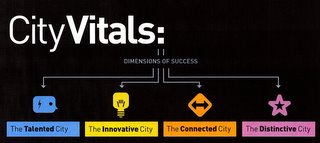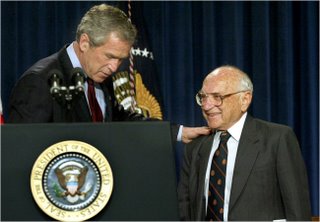Smart Decline vs. Smart Growth
While
CHRON‧I‧CLE [kron-i-kuhl]; to recount, relate, report. I-DE-A [ahy-dee-uh]; a thought, conception, or notion an impression; an opinion, view, or belief; an intention; a concept developed by the mind.
While
Posted by
Neil Abercrombie
at
4:06 PM
0
comments
![]()
 The Census Bureau just released their 2007 Statistical Abstract. The abstract contains over 1,300 tables creating a fascinating portrait of what Americans look like (fascinating to those who love data and tables). Here are some interesting results from the Census Bureau data:
The Census Bureau just released their 2007 Statistical Abstract. The abstract contains over 1,300 tables creating a fascinating portrait of what Americans look like (fascinating to those who love data and tables). Here are some interesting results from the Census Bureau data:
Posted by
Neil Abercrombie
at
9:35 AM
0
comments
![]()
According to a recent article in the Deseret News, written by Tad Walch (
True,
These statistics illustrate the challenges that many cities and towns are faced with. Can cities better address these challenges during good economic times? Definitely. But does that mean cities and towns are flush with cash? Definitely not.
Posted by
Neil Abercrombie
at
3:00 PM
2
comments
![]()
 So what makes city a successful city? Well according the CEOs for Cities it takes a combination of talent, innovation, connection, and a distinctive nature. A recent presentation at the CEOs for Cities conference in Miami attempted to measure the top 50 metropolitan areas based on these for dimensions. Here is a review of the indexes included for each dimension.
So what makes city a successful city? Well according the CEOs for Cities it takes a combination of talent, innovation, connection, and a distinctive nature. A recent presentation at the CEOs for Cities conference in Miami attempted to measure the top 50 metropolitan areas based on these for dimensions. Here is a review of the indexes included for each dimension.
The TALENTED City: a)College attainment, b)Creative Professionals, c)Young & Restless residents, d)Traded sector talent, and e)International talent.
The INNOVATIVE City: a)Patents, b)Venture Capital, c)Self-employment, and d)Small businesses
The CONNECTED City: a)Voting, b)Community Involvement, c)Economic integration, d)Transit use, e)International students, f)Foreign travel, and g)Internet connectivity
The DISTINCTIVE City: a)Weirdness index, b)Culture, c)Restaurant Variety, and d)Movie variety.
So where does Salt Lake Rank?
Posted by
Neil Abercrombie
at
4:31 PM
0
comments
![]()
| This is a recent focus group video regarding 'making better communities.' The video is a collection of comments from four focus groups across the state of Utah regarding the quality of life in our neighborhoods and polices that are important to maintaining/improving this ideal. Groups were moderated by Dan Jones & Associates, commissioned by ULCT. The video is around 14 minutes long, but just takes a minute or two to download. | |
Posted by
Neil Abercrombie
at
10:16 PM
0
comments
![]()

Milton Friedman died today, at 94 years of age.
The New York Times described Friedman as "the grandmaster of conservative economic theory in the postwar era and a prime force in the movement of nations toward lesser government and greater reliance on free markets and individual responsibility."
Hoover Institute press release
New York Times article
I'm including a great video of Friedman's interview with Richard Heffner on The Open Mind, December 7, 1975. The video is around 30 minutes and takes a minute to download, but trust me it is worth it. Great interview. Check here.
Posted by
Neil Abercrombie
at
3:27 PM
0
comments
![]()
What should be the role of the Federal Reserve? Should the Reserve be more transparent to the general public? Will there be a policy shift from Alan Greenspan to Benjamin Bernanke? And is Greenspan to blame for the latest housing bubbles that seem to be emerging nationwide?
I found this recent article in Reason extremely interesting, exploring these questions and more. Reason asked five key Fed watchers to assess these Federal Reserve issues.
Posted by
Neil Abercrombie
at
11:25 AM
0
comments
![]()
While attorneys, candidates, pundits, etc. count votes in
According to NCSL election analyst Jennie Drage Bowser, “They (Americans) were reluctant to approve measures to reduce government power but receptive to conservative-leaning measures. Liberal-leaning measures received mixed results.” For example:
Posted by
Neil Abercrombie
at
11:57 AM
1 comments
![]()
It is interesting that citizens do not know more about their local government taxes. Citizens are using local government services daily (water, sewer, garbage, libraries, roads, parks) yet, they have no idea how these services are funded. And a better question is, do citizens change their tax preferences with increased knowledge? This graph illustrates data from our Dan Jones conducted Tax Survey that indicates, that yes tax preferences do change with increased knowledge.
This is the issue Brian Roberts and I explore in our paper Citizen's Blank Check. We presented the findings of our study last week at the APPAM (Association for Public Policy Analysis and Management) conference in
One interesting suggestion was to explore whether new homeowners have better property tax knowledge than "seasoned" homeowners. The logic is individuals who have made a recent home purchase have looked closely at their property tax bill for the new property. I'm not sure what the results would be, I'm inclined to say that it wouldn't matter. Maybe it will be something we'll look to explore more. In the meantime (if you are very inquisitive or love taxes) you can read our paper here.
Posted by
Neil Abercrombie
at
12:04 AM
0
comments
![]()

America reached a milestone at the end of October, 300 million Americans. TIME magazine provided a recent breakdown of America "by the numbers." Their data provided some interesting descriptions on who we are today as Americans. For example FOR EVERY 1000 AMERICANS...
Posted by
Neil Abercrombie
at
8:09 PM
0
comments
![]()
Labels: growth, population
Did anyone see this article in the recent Economist? Third quarter GDP indicate the economy grew at a 1.6% annualized rate. Which is much less than most predicted and a full point lower than the previous three months. Decline in homebuilding accounts for a large portion of this GDP decline, with residential homebuilding declining by 17% this most recent quarter. According to The Economist the declines in house building accounted for two-fifths of the quarterly fall in GDP growth. See the full article here.
So what does this mean? According to the FDIC (Federal Deposit Insurance Corporation)
Posted by
Neil Abercrombie
at
11:32 PM
0
comments
![]()
Okay, so after months of anticipation (by whom you might ask) the League of Cities and Towns is launching a new website....and along with that a new blog for me. We'll see how long this lasts. Kind of feels like a New Year's resolution, I'm going to be more optimistic that this lasts longer than one week. I'm hopeful that this blog will remain up to date and provide some utility to those visiting our website.
And some utility in allowing me to discuss ideas, solicit feedback, and sort through some important policy questions.
Posted by
Neil Abercrombie
at
11:16 PM
0
comments
![]()
